CHEVROLET SUBURBAN 1994 Repair Manual
Manufacturer: CHEVROLET, Model Year: 1994, Model line: SUBURBAN, Model: CHEVROLET SUBURBAN 1994Pages: 385, PDF Size: 19.88 MB
Page 61 of 385
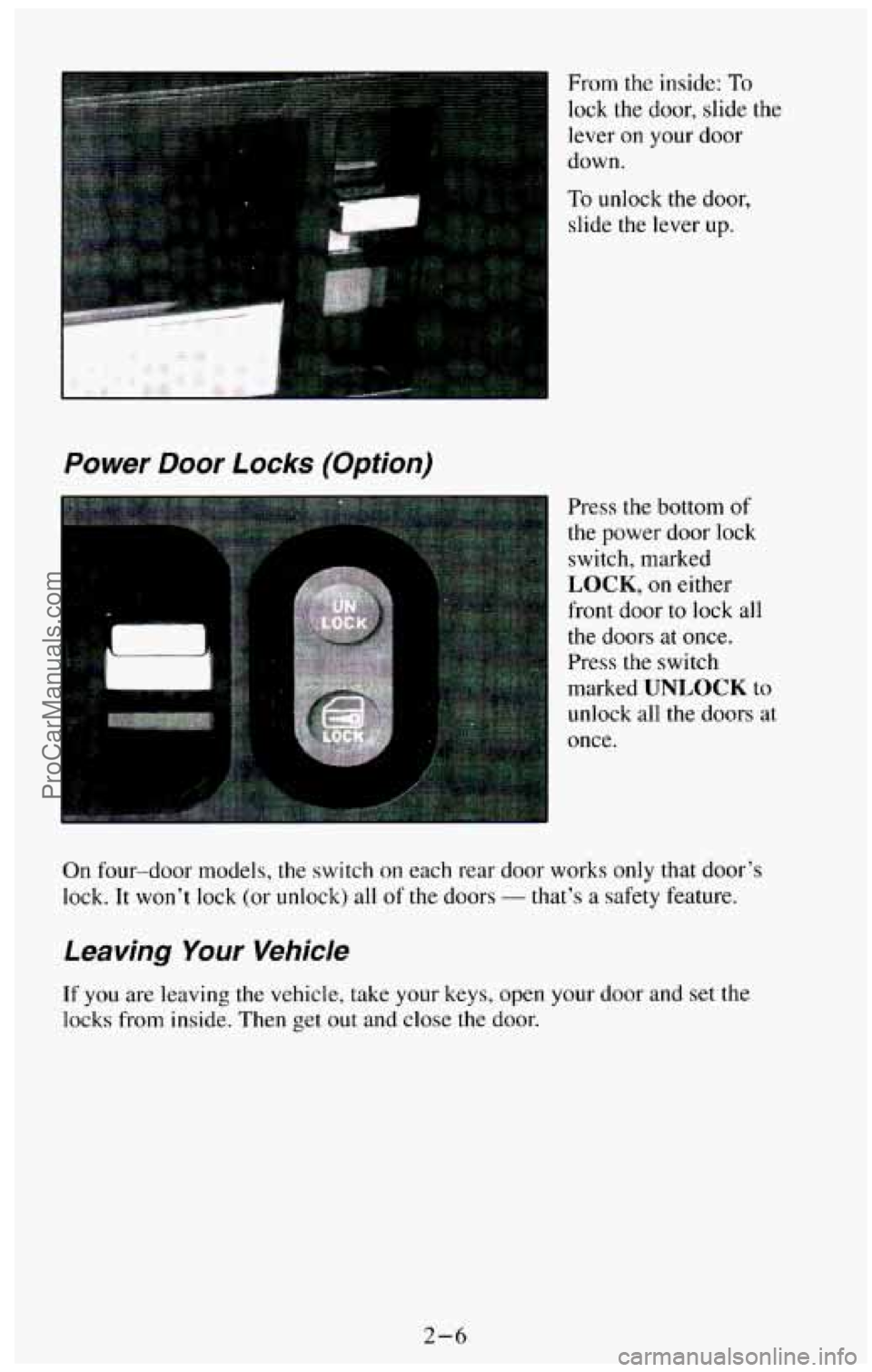
From the inside: To
lock the door, slide the
lever on your door
down.
To unlock the door,
slide the lever up.
Power Door Locks (Option)
Press the bottom of
the power door lock
switch, marked
LOCK, on either
front door to lock all
the doors
at once.
Press the switch
marked
UNLOCK to
unlock
all the doors at
once.
On four-door models,
the switch on each rear door works only that door’s
lock. It won’t
lock (or unlock) all of the doors - that’s a safety feature.
Leaving Your Vehicle
If you are leaving the vehicle, take your keys, open your door and set the
locks from inside. Then get out and close the door.
2-6
ProCarManuals.com
Page 62 of 385
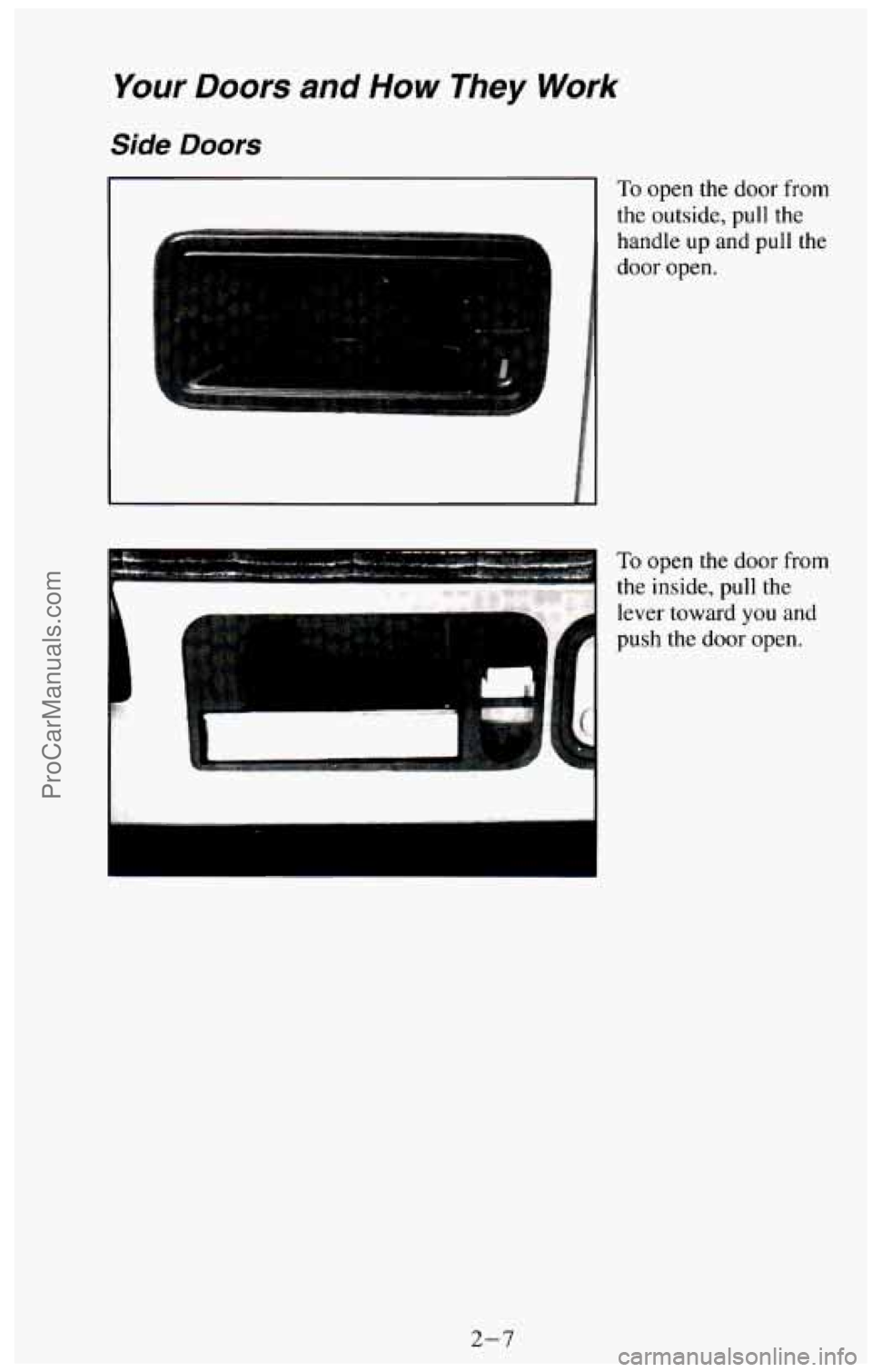
Your Doors and How They Work
Side Doors
To open the door from
the outside, pull the
handle
up and pull the
door open.
To open the door from
the inside, pull the
lever toward
you and
push the door open.
2-7
ProCarManuals.com
Page 63 of 385
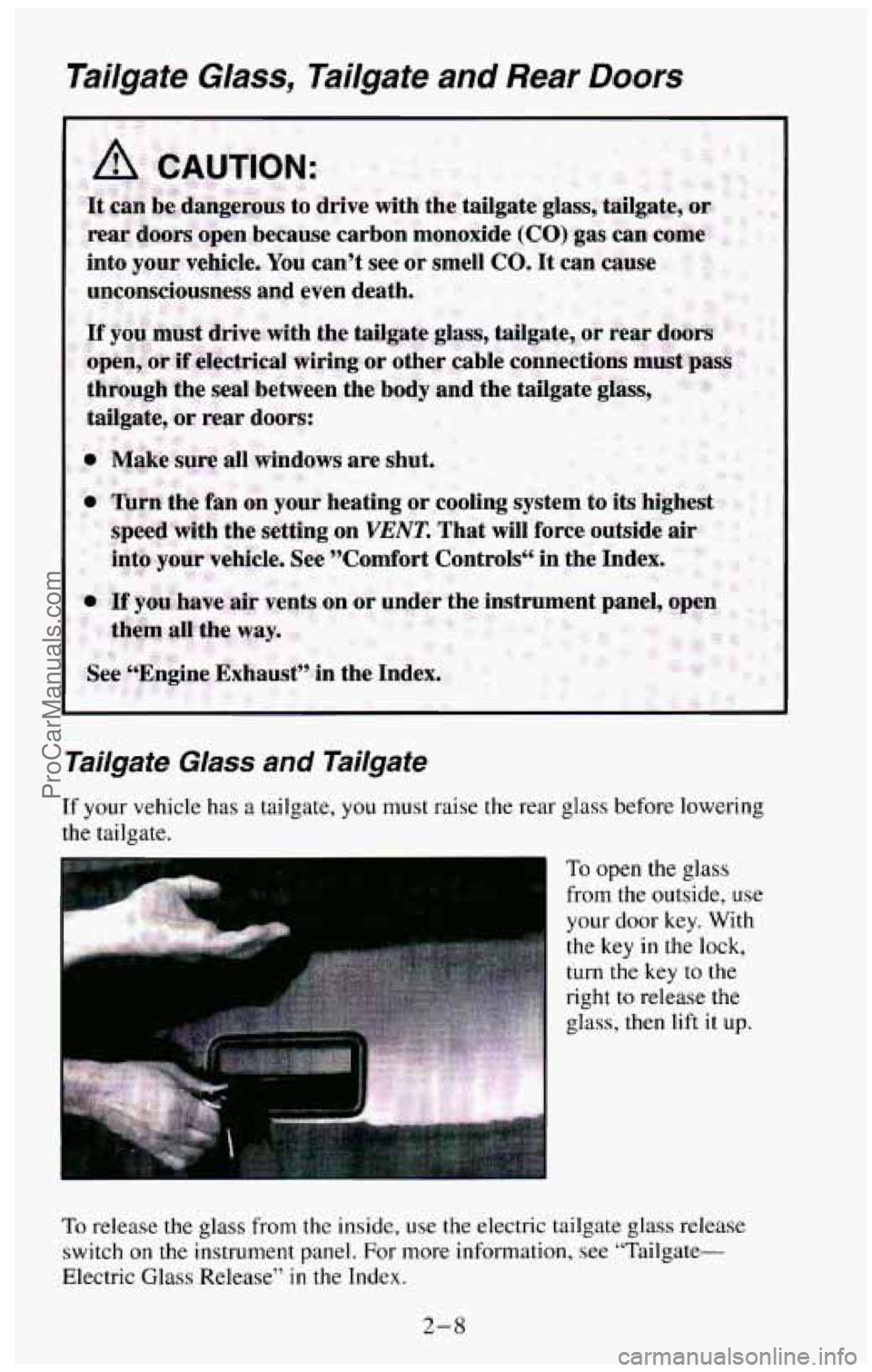
Tailgate Glass, Tailgate and Rear Doors
into your vehicle. You can't see or smell CO. It can cause
unconsciousness
and even death.
into your ve :le. See "Comfort Controls'' in the Fdex. &
tailgate, or rear doors: I
Tailgate Glass and Tailgate
If your vehicle has a tailgate, you must raise the rear glass before lowering
the tailgate.
To open the glass
from the outside, use
your door key. With
the
key in the lock,
turn the key to the
To release the glass from the inside, use the electric tailgate glass release
switch
on the instrument panel. For more information, see ''Tailgate-
Electric Glass Release"
in the Index.
2-8
ProCarManuals.com
Page 64 of 385
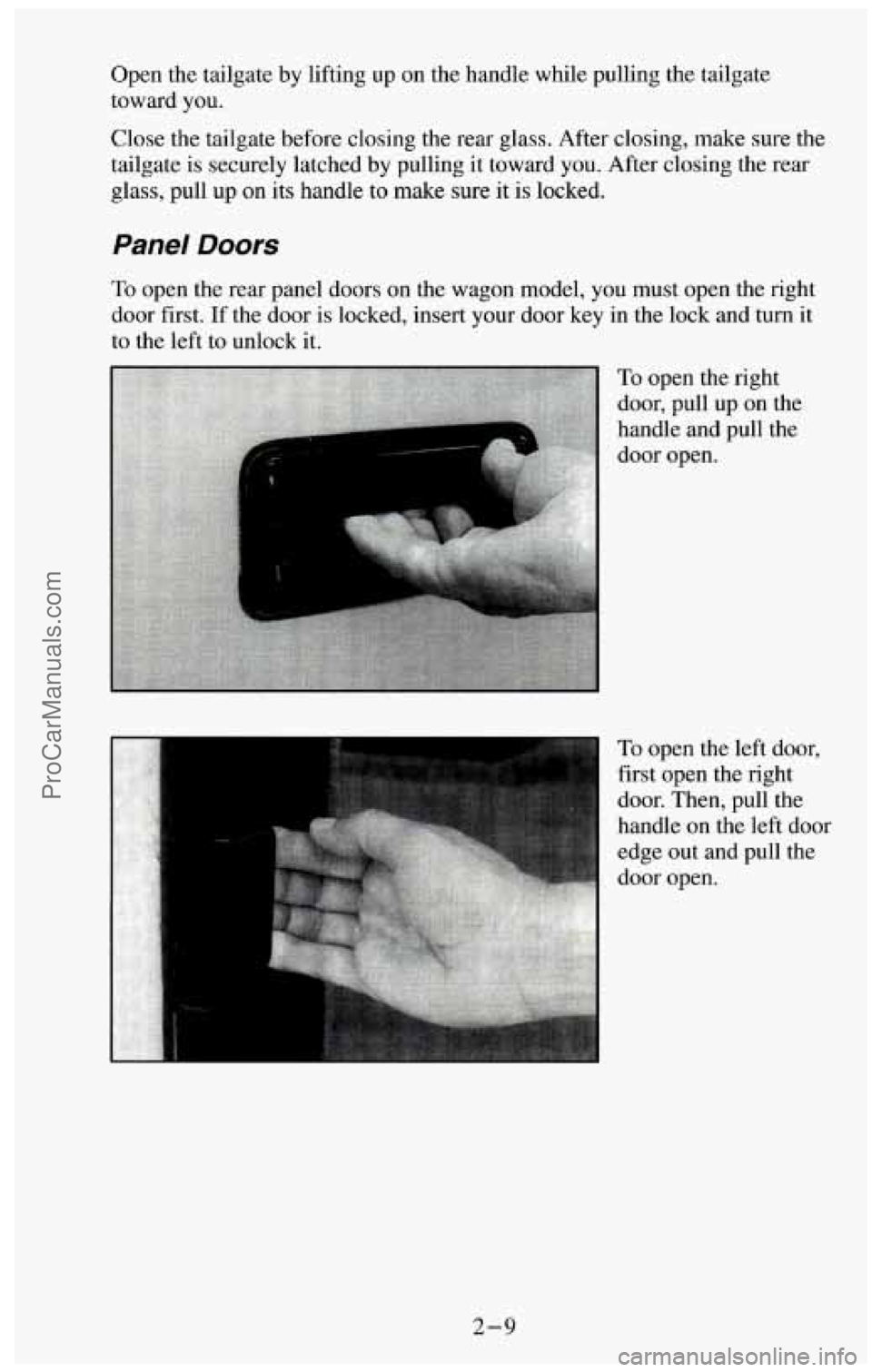
Open the tailgate by lifting up on the handle while pulling the tailgate
toward you.
Close the tailgate before closing the rear glass. After closing, make sure the
tailgate
is securely latched by pulling it toward you. After closing the rear
glass, pull up
on its handle to make sure it is locked.
Panel Doors
To open the rear panel doors on the wagon model, you must open the right
door first.
If the door is locked, insert your door key in the lock and turn it
to the left to unlock it.
To open the right
door, pull up on the
handle and pull the
door open.
To open the left door,
first open the right
door.
Then, pull the
handle on the left door
edge out and pull the
door
open.
2-9
ProCarManuals.com
Page 65 of 385
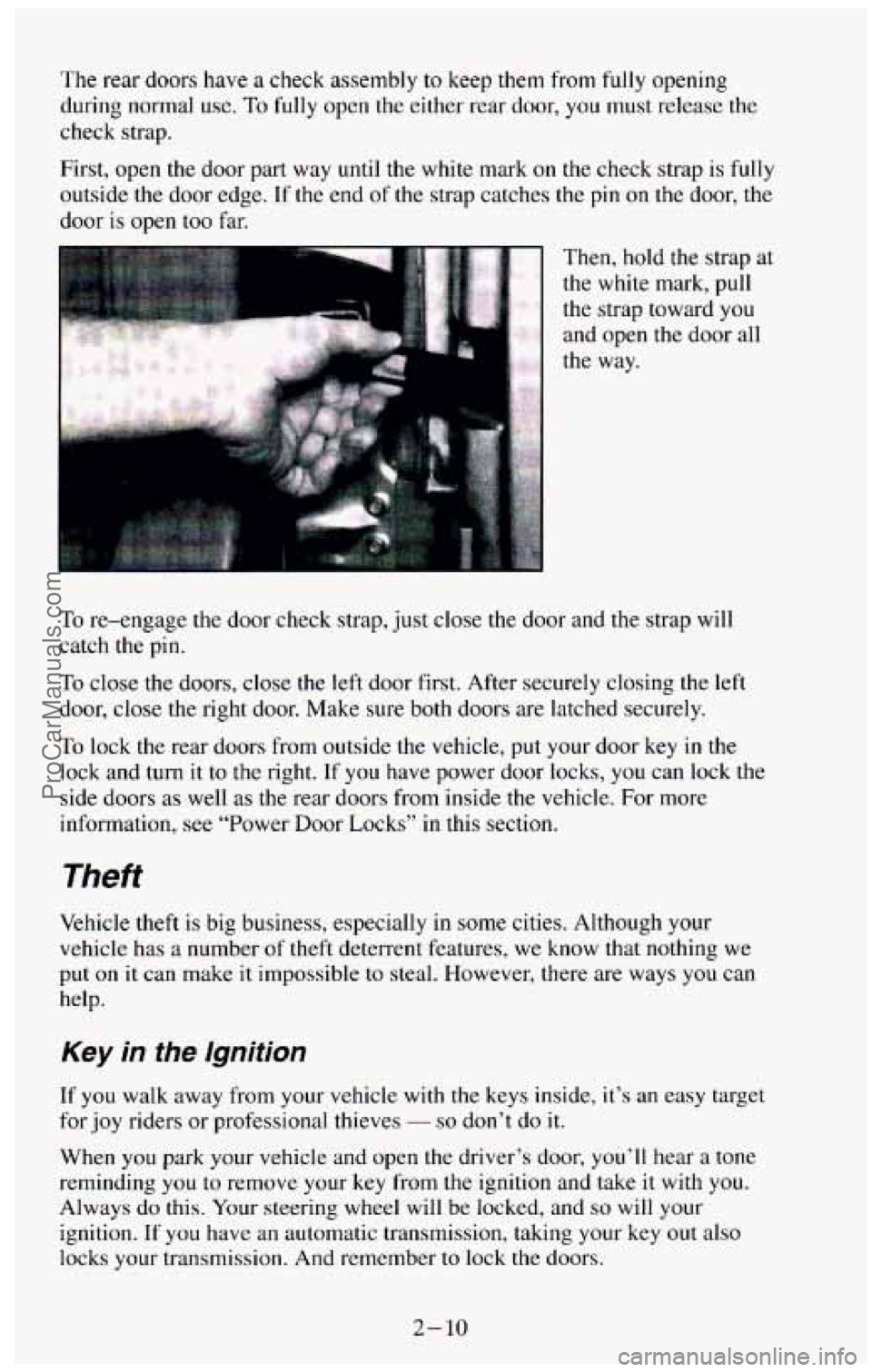
The rear doors have a check assembly to keep them from fully opening
during normal use.
To fully open the either rear door, you must release the
check strap.
First, open the door part way
until the white mark on the check strap is fully
outside the door edge. If the end of the strap catches the pin on the door, the
door is open too far,
Then, hold the strap at
the white mark, pull
the strap toward
you
and open the door all
the way.
To re-engage the door check strap, just close the door and the strap will
catch the pin.
To close the doors, close the left door first. After securely closing the left
door, close the right door. Make sure both doors are latched securely.
To lock the rear doors from outside the vehicle, put your door key in the
lock and turn it to the right. If you have power door locks, you can lock the
side doors as well as the rear doors from inside the vehicle. For more
information, see “Power Door Locks” in this section.
Theft
Vehicle theft is big business, especially in some cities. Although your
vehicle has a number of theft deterrent features, we
know that nothing we
put
on it can make it impossible to steal. However, there are ways you can
help.
Key in the lgnition
If you walk away from your vehicle with the keys inside, it’s an easy target
for
joy riders or professional thieves - so don’t do it.
When you park your vehicle and open the driver’s door, you’ll hear a tone
reminding
you to remove your key from the ignition and take it with you.
Always
do this. Your steering wheel will be locked, and so will your
ignition.
If you have an automatic transmission, taking your key out also
locks your transmission. And remember to lock the doors.
2- 10
ProCarManuals.com
Page 66 of 385
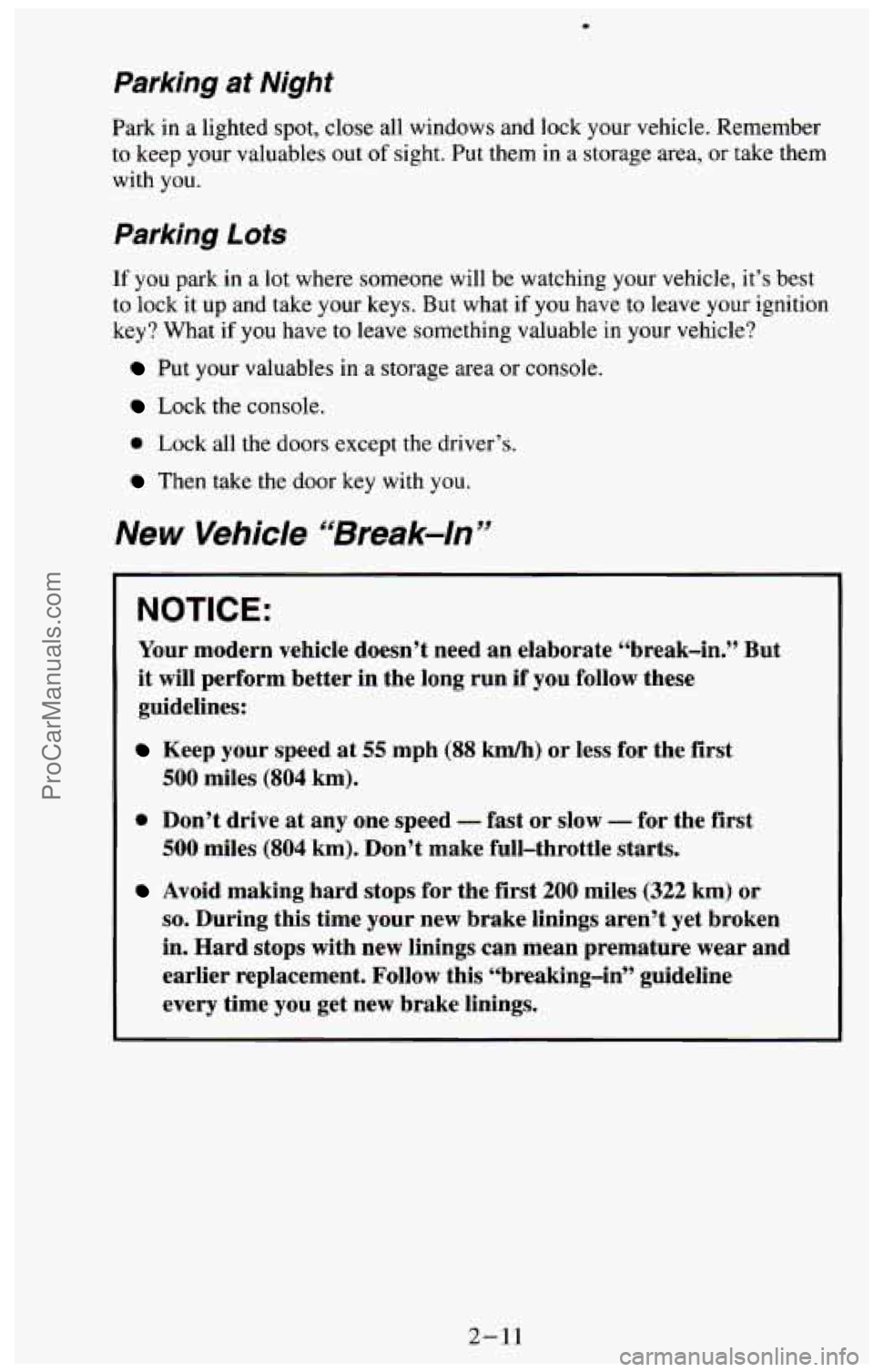
Parking at Night
Park in a lighted spot, close all windows and lock your vehicle. Remember
to keep your valuables out
of sight. Put them in a storage area, or take them
with you.
Parking Lots
If you park in a lot where someone will be watching your vehicle, it’s best
to lock it up and take your keys. But what if you have to leave your ignition
key? What if you have to leave something valuable
in your vehicle?
Put your valuables in a storage area or console.
Lock the console.
0 Lock all the doors except the driver’s.
Then take the door key with you.
New Vehicle “Break=/#”
NOTICE:
Your modern vehicle doesn’t need an elaborate “break-in.” But
it will perform better in the long run
if you follow these
guidelines:
Keep your speed at 55 mph (88 km/h) or less for the first
500 miles (804 km).
0 Don’t drive at any one speed - fast or slow - for the first
500 miles (804 km), Don’t make full-throttle starts.
Avoid making hard stops for the first 200 miles (322 km) or
so. During this time your new brake linings aren’t yet broken
in. Hard stops with new linings can mean premature wear and
earlier replacement. Follow this “breaking-in” guideline
every time
you get new brake linings,
2-11
ProCarManuals.com
Page 67 of 385
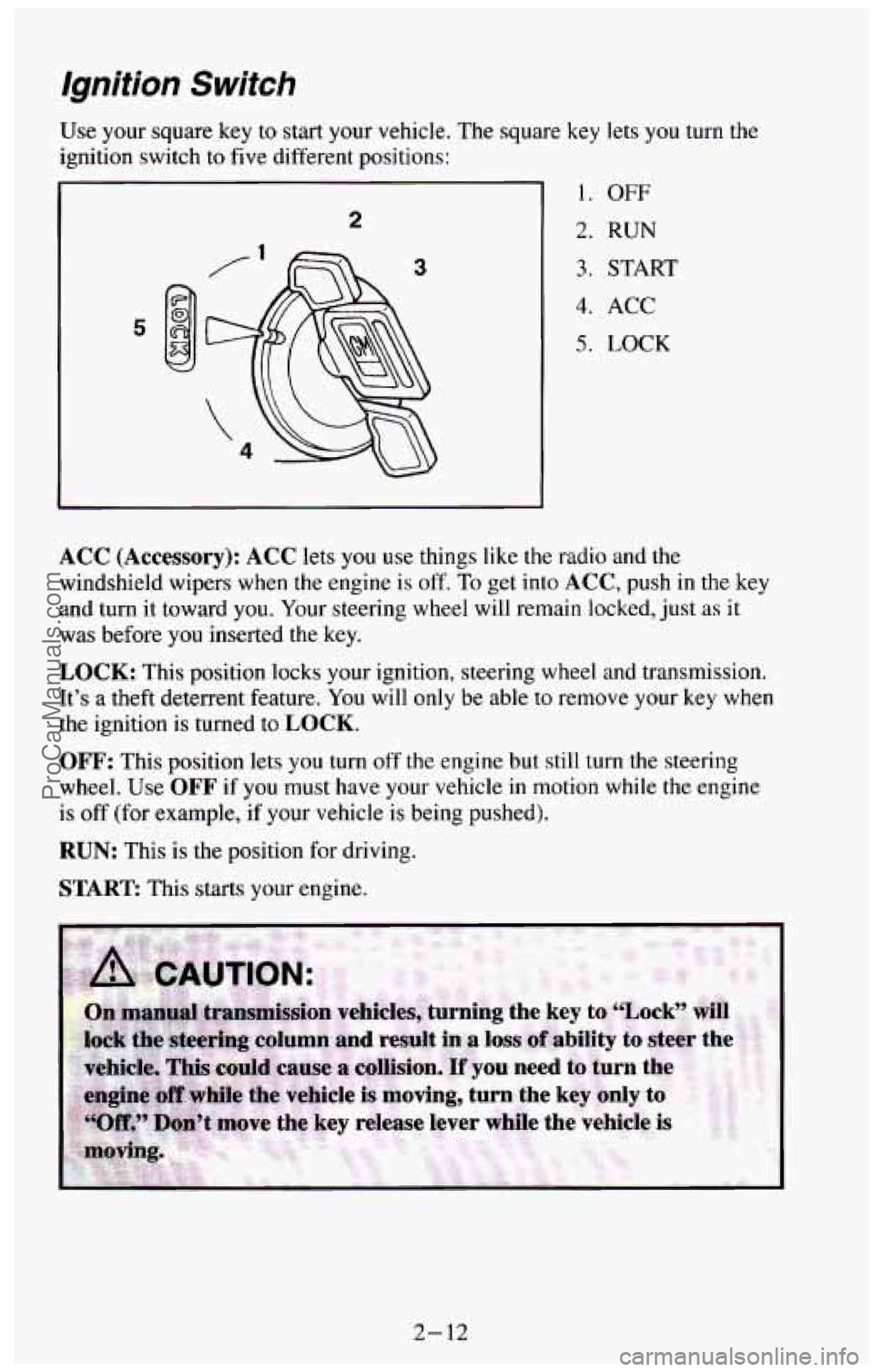
Ignition Switch
Use your square key to start your vehicle. The square key lets you turn the
ignition switch to five different positions: -
I
5
2
3
1. OFF
2. RUN
3. START
4. ACC
5. LOCK
ACC (Accessory): ACC lets you use things like the radio and the
windshield wipers when the engine is
off. To get into ACC, push in the key
and turn it toward you. Your steering wheel
will remain locked, just as it
was before
you inserted the key.
LOCK: This position locks your ignition, steering wheel and transmission.
It’s a
theft deterrent feature. You will only be able to remove your key when
the ignition is turned to LOCK.
OFF: This position lets you turn off the engine but still turn the steering
wheel. Use
OFF if you must have your vehicle in motion while the engine
is
off (for example, if your vehicle is being pushed).
RUN: This is the position for driving.
START This starts your engine.
2- 12
ProCarManuals.com
Page 68 of 385
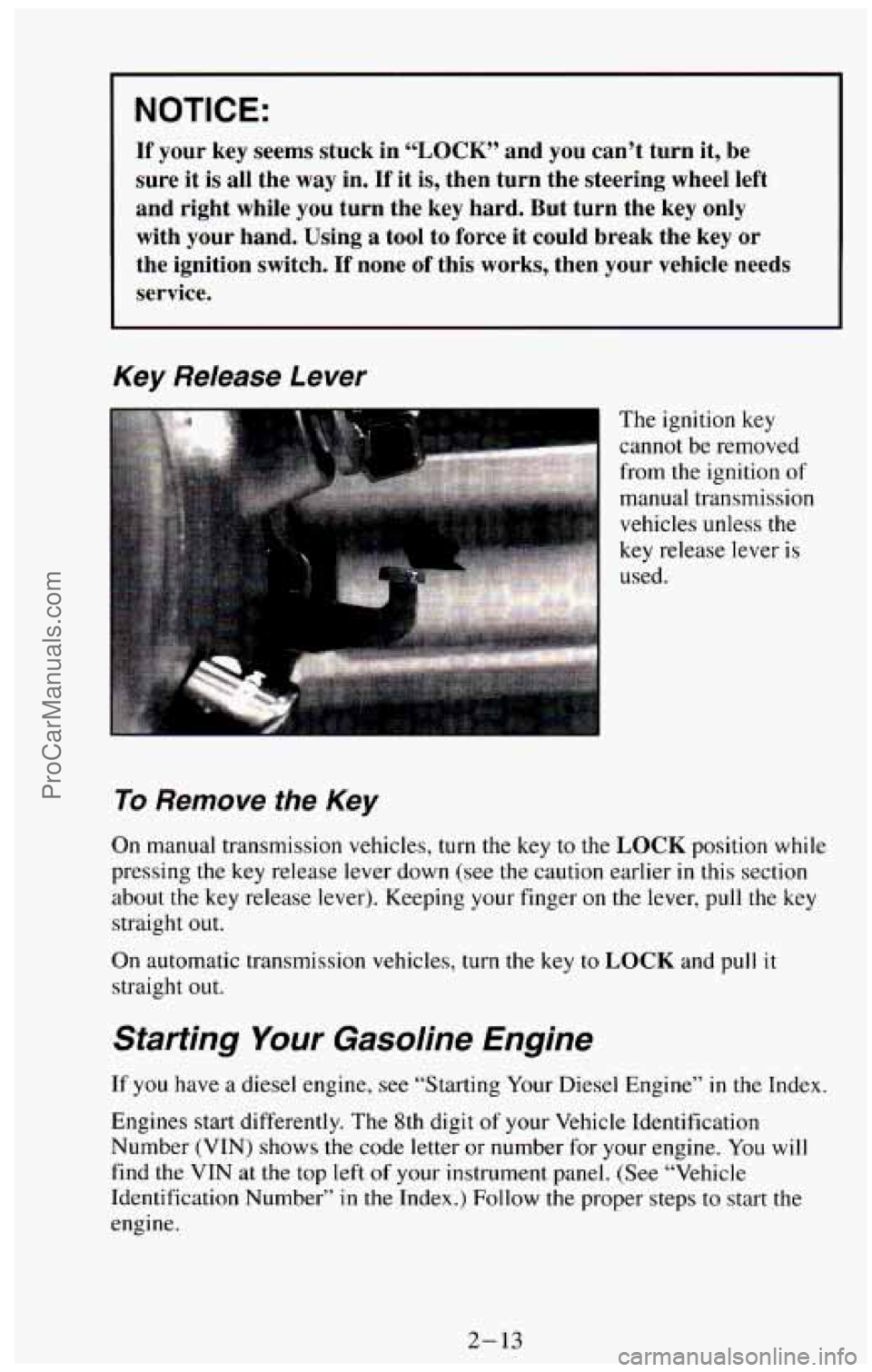
NOTICE:
If your key seems stuck in “LOCK” and you can’t turn it, be
sure it is all the way in.
If it is, then turn the steering wheel left
and right while
you turn the key hard. But turn the key only
with your hand. Using a tool to force
it could break the key or
the ignition switch.
If none of this works, then your vehicle needs
service.
Key Release Lever
The ignition key
cannot be removed
from the ignition of
.. manual transmission
vehicles unless the
To Remove the Key
On manual transmission vehicles, turn the key to the LOCK position while
pressing the key release lever down (see the caution earlier
in this section
about the key release lever). Keeping your finger
on the lever, pull the key
straight out.
On automatic transmission vehicles, turn the
key to LOCK and pull it
straight out.
Starting Your Gasoline Engine
If you have a diesel engine, see “Starting Your Diesel Engine” in the Index.
Engines start differently. The
8th digit of your Vehicle Identification
Number (VIN) shows the code letter or number for your engine.
You will
find the VIN at the top left of your instrument panel. (See “Vehicle
Identification Number” in
the Index.) Follow the proper steps to start the
engine.
2-13
ProCarManuals.com
Page 69 of 385
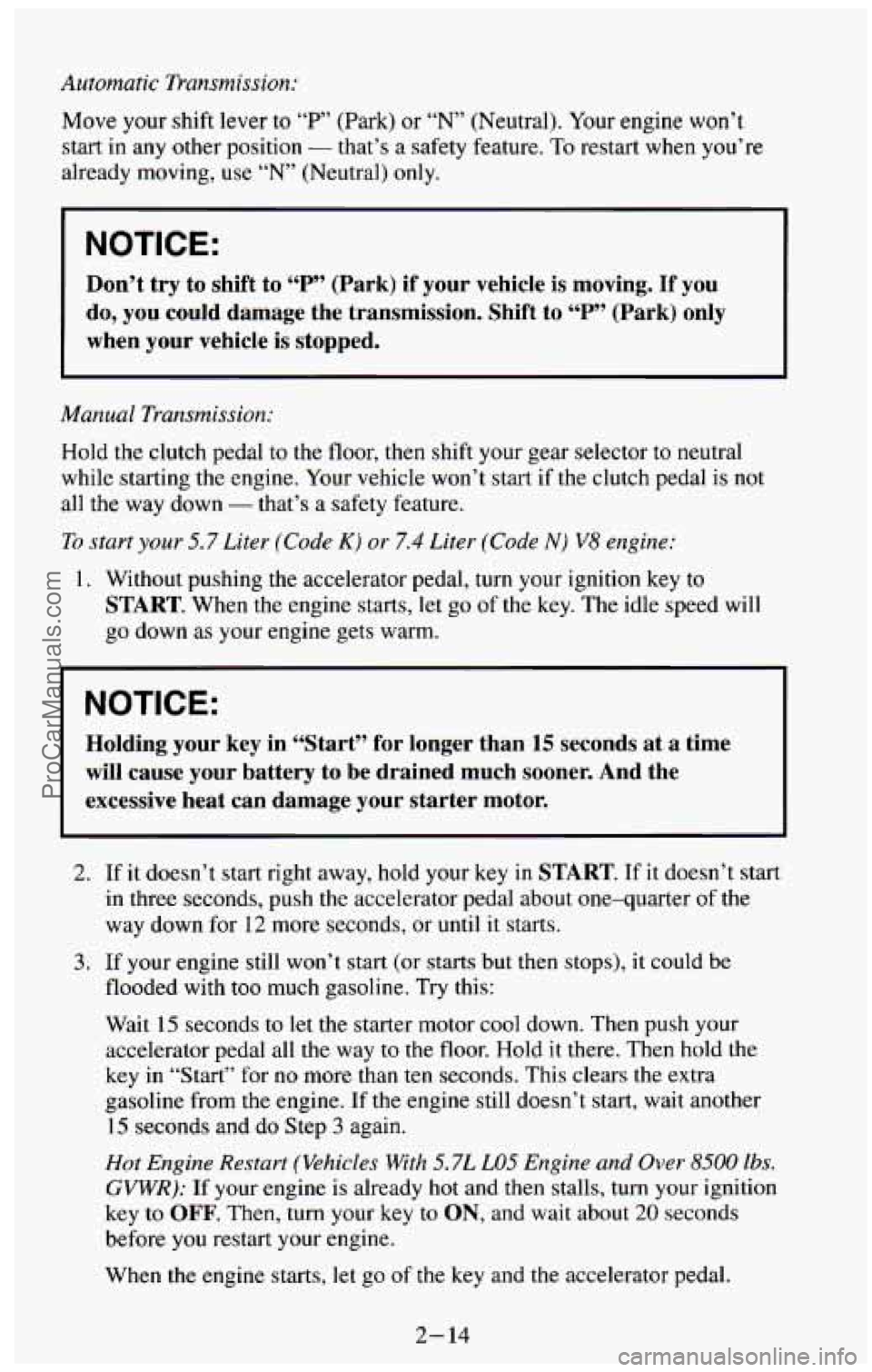
Automatic Transmission:
Move your shift lever to “P’ (Park) or “N” (Neutral). Your engine won’t
start in any other position
- that’s a safety feature. To restart when you’re
already moving, use
“N’ (Neutral) only.
NOTICE:
Don’t try to shift to “P” (Park) if your vehicle is moving. If you
do, you could damage the transmission. Shift to “P” (Park) \
only
when your vehicle is stopped.
Manual Transmission:
Hold the clutch pedal to the floor, then shift your gear selector to neutral
while starting the engine. Your vehicle won’t start if the clutch pedal is not
all the way down
- that’s a safety feature.
To start your 5.7 Liter (Code K) or 7.4 Liter (Code N) V8 engine:
1. Without pushing the accelerator pedal, turn your ignition key to
START. When the engine starts, let go of the key. The idle speed will
go down
as your engine gets warm.
NOTICE:
Holding your key in “Start” for longer than 15 seconds at a time
will cause your battery to be drained much sooner. And the
excessive heat can damage your starter motor.
2. If it doesn’t start right away, hold your key in START. If it doesn’t start
in three seconds, push
the accelerator pedal about one-quarter of the
way down for
12 more seconds, or until it starts.
flooded with too much gasoline. Try this:
3. If your engine still won’t start (or starts but then stops), it could be
Wait
15 seconds to let the starter motor cool down. Then push your
accelerator pedal all the way to
the floor. Hold it there. Then hold the
key in “Start” for
no more than ten seconds. This clears the extra
gasoline from the engine. If the engine still doesn’t start, wait another
15 seconds and do Step 3 again.
Hot Engine Restart (Vehicles With 5.7L LO5 Engine and Over 8500 lbs.
GVWR): If your engine is already hot and then stalls, turn your ignition
key to
OFF. Then, turn your key to ON, and wait about 20 seconds
before you restart your engine.
When the engine starts,
let go of the key and the accelerator pedal.
2- 14
ProCarManuals.com
Page 70 of 385
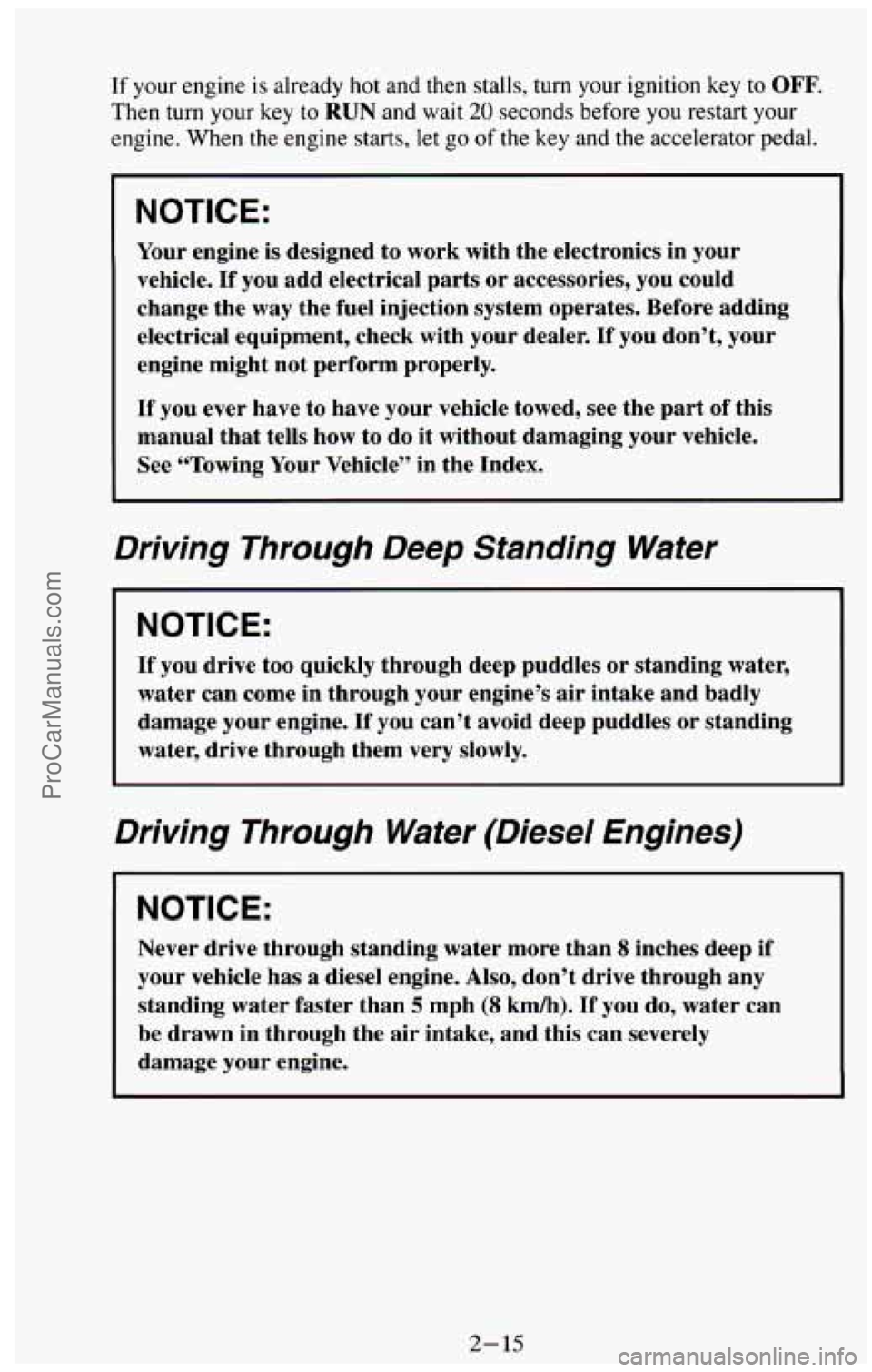
If your engine is already hot and then stalls, turn your ignition key to OFF.
Then turn your key to RUN and wait 20 seconds before you restart your
engine. When the engine starts, let
go of the key and the accelerator pedal.
NOTICE:
Your engine is designed to work with the electronics in your
vehicle. If you add electrical parts or accessories, you could
change the way the fuel injection system operates. Before adding
electrical equipment, check with your dealer.
If you don’t, your
engine might not perform properly.
If you ever have to have your vehicle towed, see the part of this
manual that tells how to do it without damaging your vehicle.
See “Towing Your Vehicle” in the Index.
Driving Through Deep Standing Water
NOTICE:
If you drive too quickly through deep puddles or standing water,
water can come in through your engine’s air intake and badly
damage your engine.
If you can’t avoid deep puddles or standing
water, drive through them very slowly.
Driving Through Water (Diesel Engines)
NOTICE:
Never drive through standing water more than 8 inches deep if
your vehicle has a diesel engine.
Also, don’t drive through any
standing water faster than
5 mph (8 km/h). If you do, water can
be drawn in through the air intake, and this can severely
damage your engine.
2-15
ProCarManuals.com